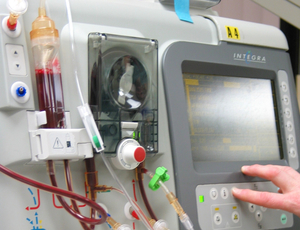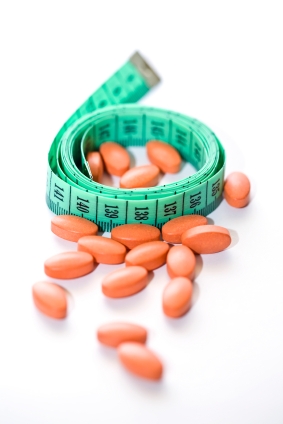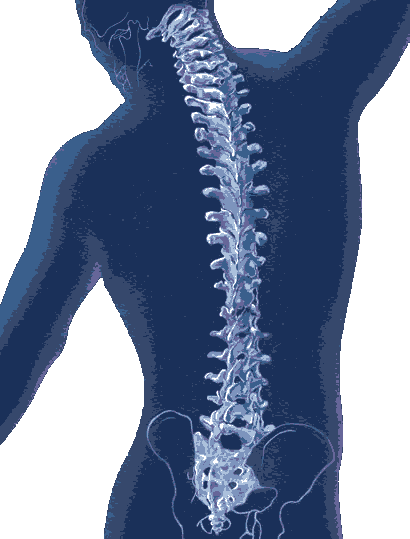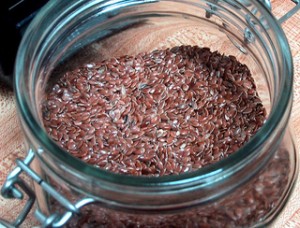 Dialysis is the artificial process of getting rid of waste (diffusion) and unwanted water (ultrafiltration) from the blood. This process is naturally done by our kidneys. Some people, however, may have failed or damaged kidneys which cannot carry out the function properly – they may need dialysis. In other words, dialysis is the artificial replacement for lost kidney function (renal replacement therapy). Dialysis may be used for people who have become ill and have acute kidney failure (temporary loss of kidney function), or for fairly stable patients who have permanently lost kidney function (stage 5 chronic kidney disease).
Dialysis is the artificial process of getting rid of waste (diffusion) and unwanted water (ultrafiltration) from the blood. This process is naturally done by our kidneys. Some people, however, may have failed or damaged kidneys which cannot carry out the function properly – they may need dialysis. In other words, dialysis is the artificial replacement for lost kidney function (renal replacement therapy). Dialysis may be used for people who have become ill and have acute kidney failure (temporary loss of kidney function), or for fairly stable patients who have permanently lost kidney function (stage 5 chronic kidney disease).
When we are healthy our kidneys regulate our body levels of water and minerals, and remove waste. The kidneys also produce erythropoietin and 1,25-dihydroxycholecalciferol (calcitriol) as part of the endocrine system. Dialysis does not correct the endocrine functions of failed kidneys – it only replaces some kidney functions, such as waste removal and fluid removal.
Dialysis and altitude – A study found that death rates for dialysis patients are 10%-15% lower for those whose homes are higher than 4,000 feet, compared to those who live at sea level.
Some countries, such as the UK, are predicting a doubling of the number of patients on dialysis machine.
Why is dialysis necessary?
Approximately 1,500 liters of blood are filtered by a healthy person’s kidneys each day. We could not live if waste products were not removed from our kidneys. People whose kidneys either do not work properly or not at all experience a buildup of waste in their blood. Without dialysis the amount of waste products in the blood would increase and eventually reach levels that would cause coma and death.
Dialysis is also used to rapidly remove toxins or drugs from the blood.
There are two main types of dialysis – hemodialysis and peritoneal dialysis
What type of dialysis a patient should have really does depend on each individual case. Studies have indicated clearly that for kidney disease patients who need to undergo dialysis, one type of treatment is not best for all.
What is hemodialysis?
The blood circulates outside the body of the patient – it goes through a machine that has special filters. The blood comes out of the patient through a catheter (a flexible tube) that is inserted into the vein. The filters do what the kidney’s do; they filter out the waste products from the blood. The filtered blood then returns to the patient via another catheter. The patient is, in effect, connected to a kind of artificial kidney.
Patients need to be prepared for hemodialysis. A blood vessel, usually in the arm, needs to be enlarged. Surgery is required for this. The enlarged vein makes the insertion of the catheters possible. US researchers have developed a new way of growing blood vessels using patients’ own skin cells to seed the growth of tissue and have tested it in dialysis patients with end stage kidney disease.
Hemodialysis usually lasts about 3 to 4 hours each week. The duration of each session depends on how well the patient’s kidneys work, and how much fluid weight the patient has gained between treatments.
In the UK hemodialysis is either done in a special dialysis center in a hospital, or at home. When it is carried out at home it is important that the patient, and/or his/her caregiver knows what to do. A study revealed that kidney disease patients who are educated about dialysis are more likely to undergo a standard but under-utilized dialysis-related procedure than less knowledgeable patients The following people may have hemodialysis done at home:
- People who can and want to learn how to do it at home.
- People who are willing to carry on doing it at home.
- People whose condition has been stable while on dialysis.
- People who do not suffer from other diseases which would make home hemodialysis unsafe.
- People who have suitable blood vessels for the insertion of the catheters.
- People who have a caregiver, and that caregiver is willing to help with hemodialysis. People whose homes can be adapted for hemodialysis equipment.
In the UK, the National Institutes of Health and Clinical Excellence (NICE) recommends that every patient deemed suitable for home dialysis should have both home dialysis and hospital offered.
What is peritoneal dialysis?
A sterile (dialysate) solution rich in minerals and glucose is run through a tube into the peritoneal cavity, the abdominal body cavity around the intestine, where the peritoneal membrane acts as a semi-permeable membrane.
The abdomen is the area between the chest and hips – it contains the stomach, small intestine, large intestine, liver, gallbladder, pancreas and spleen. Peritoneal dialysis uses the natural filtering ability of the peritoneum – the internal lining of the abdomen. In other words, peritoneal dialysis uses the lining of the abdomen as a filter of waste products from the blood.
The dialysate is left there for some time so that it can absorb waste products. Then it is drained out through a tube and discarded. This exchange, or cycle, is generally repeated several times during the day – with an automated system it is often done overnight. The elimination of unwanted water (ultrafiltration) occurs through osmosis – as the dialysis solution has a high concentration of glucose, it results in osmotic pressure which causes the fluid to move from the blood into the dialysate. Consequently, a larger quantity of fluid is drained than introduced.
Although peritoneal dialysis is not as efficient as hemodialysis, it is carried out for longer periods. The net effect in terms of total waste product and salt and water removal is about the same as hemodialysis.
Peritoneal dialysis is done at home by the patient; by a willing and motivated patient. It gives the patient a greater amount of freedom and independence because he/she does not have to come in to the clinic at multiple times each week. It can also be done while traveling with a minimum of specialized equipment. Peritoneal dialysis is said to ‘save lives and save money’.
Before having peritoneal dialysis, the patient needs to have a small surgical procedure to insert a catheter into the abdomen. This is kept closed off, except when fluid is being introduced or taken out of the abdomen.
There are two principal types of peritoneal dialysis:
- Continuous ambulatory peritoneal dialysis (CAPD) – this requires no machinery and can be done by the patient or a caregiver. The dialysate is left in the abdomen for up to eight hours. It is then replaced with a fresh solution straight away. This happens every day, about four to five times per day.
- Continuous cyclic peritoneal dialysis (CCPD) – a machine does the dialysis fluid exchanges. It is generally done during the night while the patient sleeps. This needs to be done every night. Each session lasts from ten to twelve hours. After spending the night attached to the machine, the majority of people keep fluid inside their abdomen during the day. Some patients may require another exchange during the day. A study found that a significant number of patients prefer “dialysis while you sleep” treatment. Another study found that nocturnal dialysis improves heart disease in patients with end-stage kidney failure.
Peritoneal is ideal for patients who may find hemodialysis too exhausting, such as elderly people, babies and children. As it can be done while the patient is traveling it is more convenient for those who have to go to school or to work.
A study found that a combination of aspirin and the anti-platelet drug dipyridamole significantly reduce blockages and extend the useful life of new artery-vein access grafts used for hemodialysis.
Dialysis helps, but is not as efficient as the kidneys
Although dialysis helps patients whose kidneys have failed, it is not as efficient as a normal kidney. Consequently, patients on dialysis need to be careful about what and how much they drink and eat. They will also need medications.
A significant number of patients on dialysis can work and lead normal lives. It is possible to go away on vacation as long as dialysis treatment is possible at their destination.
Women on dialysis will probably not be able to get pregnant. There will be a higher level of waste products in the body compared to a woman with normal kidneys – this interferes with fertility. Women who do become pregnant while on dialysis will probably need increased dialysis during the pregnancy. If a woman has a successful kidney transplant her fertility should return to normal. Dialysis has some effect on male fertility, but much less than on female fertility.
What are the symptoms of kidney failure?
Kidney failure tends to happen gradually. Even if just one kidney works, or both work partially, normal kidney function is still possible. So, it can be a very long time before any symptoms are noticed by the patient. When symptoms do occur they tend to be different from person-to-person, making it harder for doctors to diagnose kidney failure quickly. The following symptoms may be present:
- Fatigue (tiredness)
- Frequent need to urinate, especially at night. Frequency grows with time
- Itchy skin
- Erectile dysfunction (men have difficulty getting and/or sustaining an erection)
- Nausea
- Shortness of breath
- Water retention (swollen feet, hands, ankles)
- Blood in urine
- Protein in urine
A sudden injury can cause kidney failure. When it does, symptoms tend to appear faster, and progress more rapidly as well.
Anemia – People with chronic kidney disease are usually affected by anemia (90% of them). When levels of EPO (erythropoietin), which is produced by the kidneys, are low, anemia can develop. EPO makes the body produce red blood cells. When your red blood cell count is low you have anemia. Chronic kidney failure patients who have anemia are usually given an ESA (erythropoiesis-stimulating agent) injection. A study found that Ferumoxytol, a novel intravenous form of iron that permits rapid administration of large doses, is effective for treating iron deficiency in chronic kidney disease (CKD) patients on dialysis.
What are the causes of kidney disease?
- Diabetes – thought to cause about half of all cases
- Hypertension (high blood pressure) – thought to cause about one quarter of all cases
- Inflammation of the kidney (glomerulonephritis)
- Malaria
- Long-term exposure to lead, solvents and fuels
- Systemic lupus erythematosus – body’s own immune system attacks the kidneys
- Polycystic kidney disease – inherited
- Physical injury, such as a heavy blow to the kidney
- Kidney infection (pyelonephritis)
- Jaundice
- Over consumption of some medications
- Unborn baby does not normally developing kidneys
- Yellow fever
Written by Christian Nordqvist
Copyright: Medical News Today


 A New Drug Delivers “Fitness” Without the Workout
A New Drug Delivers “Fitness” Without the Workout Myofascial Pain in Athletes
Myofascial Pain in Athletes Women Age 30+ Modify Breast Cancer Risk With Exercise
Women Age 30+ Modify Breast Cancer Risk With Exercise Individuals Genetically At Risk Of Developing Psychological Disorders Also Benefit The Most From Positive Environments
Individuals Genetically At Risk Of Developing Psychological Disorders Also Benefit The Most From Positive Environments Survey Flushes Out The Secrets Of Americans’ Bathroom Habits
Survey Flushes Out The Secrets Of Americans’ Bathroom Habits Florida: Congressman Gus Bilirakis Introduces Sleep Apnea Awareness Bill to Congress
Florida: Congressman Gus Bilirakis Introduces Sleep Apnea Awareness Bill to Congress
 New vegetarian omega-3 from Echium seed oil offers fish oil benefits. In the wake of National Vegetarian week, nutrition scientist Dr Nina Bailey discusses a new vegetarian source of omega-3 fatty acids from echium seed oil, which converts to long-chain fatty acids up to 5 times more effectively than flaxseed.
New vegetarian omega-3 from Echium seed oil offers fish oil benefits. In the wake of National Vegetarian week, nutrition scientist Dr Nina Bailey discusses a new vegetarian source of omega-3 fatty acids from echium seed oil, which converts to long-chain fatty acids up to 5 times more effectively than flaxseed.